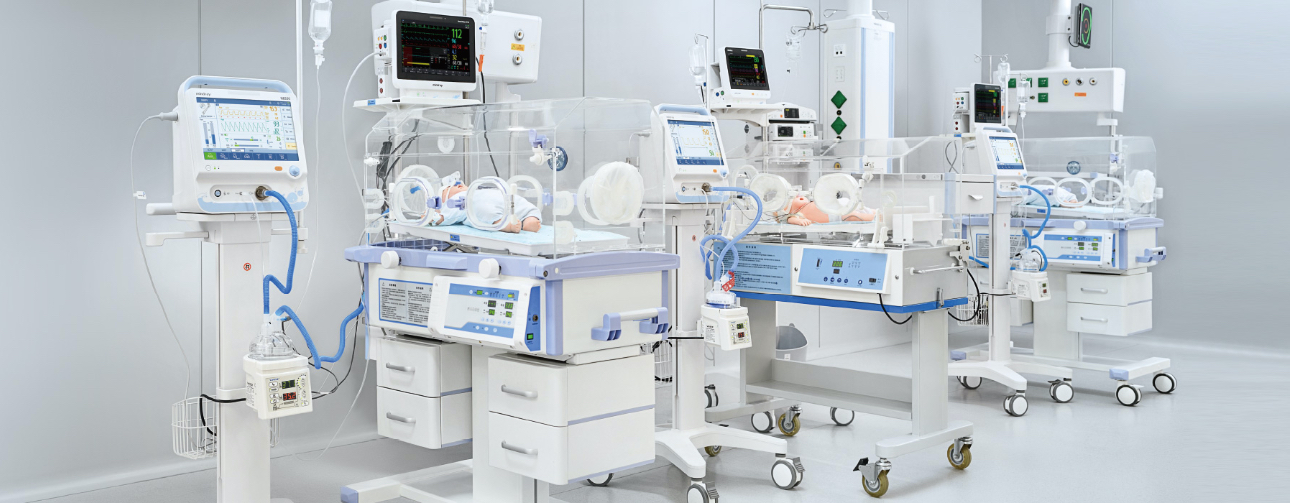The global neonatal ventilators market has shown impressive growth, with its size valued at USD 407.9 million in 2023. The Asia Pacific region holds a significant share of this market, driven largely by technological advancements in ventilator technology. The market is projected to grow at a compound annual growth rate (CAGR) of 6.41% from 2024 to 2032, aiming to reach USD 714.2 million by 2032. This growth underscores the crucial role of neonatal ventilators in enhancing neonatal care and improving survival rates for preterm and critically ill infants. This comprehensive analysis explores the key factors driving this market’s growth, technological advancements, regional dynamics, competitive landscape, challenges, and future trends.
Market Overview
Current Market Size and Share The neonatal ventilators market, valued at USD 407.9 million in 2023, is witnessing robust growth. The Asia Pacific region is a significant contributor to this market, thanks to its large population base, rising healthcare expenditure, and increasing awareness about neonatal care. This region’s substantial market share can be attributed to the rapid adoption of advanced medical technologies and the increasing number of neonatal intensive care units (NICUs).
Historical Market Growth The market has experienced steady growth over the past few years, driven by the rising incidence of preterm births and advancements in neonatal care. Historical data indicates a consistent increase in the demand for neonatal ventilators, reflecting improvements in healthcare infrastructure and the growing focus on enhancing neonatal survival rates.
Key Drivers of Market Growth
Technological Advancements Technological innovations have been at the forefront of the neonatal ventilators market’s growth. Modern ventilators come equipped with sophisticated features that significantly improve their functionality and efficacy. These advancements include enhanced ventilation modes, integrated monitoring systems, and user-friendly interfaces that allow for precise control and customization of ventilation parameters.
Increasing Preterm Birth Rates The global rise in preterm birth rates is a major driver for the neonatal ventilators market. According to the World Health Organization (WHO), an estimated 15 million babies are born preterm each year, and this number is rising. Preterm infants often require respiratory support, making neonatal ventilators indispensable in NICUs. The high incidence of respiratory distress syndrome (RDS) among preterm infants further fuels the demand for these devices.
Rising Awareness and Healthcare Expenditure Growing awareness about the importance of neonatal care has led to increased healthcare spending worldwide. Governments and private organizations are investing heavily in healthcare infrastructure, including the establishment of specialized NICUs equipped with advanced neonatal ventilators. Public health campaigns and educational initiatives are also raising awareness about the benefits of early and effective neonatal care.
Technological Advancements in Neonatal Ventilators
Enhanced Ventilator Features Modern neonatal ventilators are equipped with a range of advanced features designed to improve patient outcomes. These include synchronized intermittent mandatory ventilation (SIMV), pressure support ventilation (PSV), and high-frequency oscillatory ventilation (HFOV). These modes allow for more precise and controlled ventilation, reducing the risk of ventilator-induced lung injury and improving overall respiratory support.
Non-invasive Ventilation Techniques Non-invasive ventilation (NIV) techniques are gaining popularity in neonatal care due to their less invasive nature and reduced risk of complications. NIV methods, such as nasal continuous positive airway pressure (nCPAP) and nasal intermittent positive pressure ventilation (NIPPV), provide effective respiratory support without the need for endotracheal intubation. These techniques are particularly beneficial for preterm infants with mild to moderate respiratory distress.
Smart Ventilators and AI Integration The integration of artificial intelligence (AI) and machine learning in neonatal ventilators is revolutionizing neonatal care. Smart ventilators equipped with AI algorithms can continuously monitor and adjust ventilation parameters based on the infant’s respiratory needs. This real-time adaptation ensures optimal respiratory support and reduces the risk of human error. AI-driven ventilators also provide valuable data insights, aiding clinicians in making informed decisions.
Get a Free Sample Report with Table of Contents – https://www.expertmarketresearch.com/reports/asia-pacific-neonatal-ventilators-market/requestsample
Regional Market Analysis
Asia Pacific Market Dynamics The Asia Pacific region holds a significant share of the neonatal ventilators market due to several factors. Rapid economic growth, increasing healthcare investments, and rising awareness about neonatal care are key drivers. Countries like China, India, and Japan are leading the region’s market, with substantial government initiatives and funding for healthcare infrastructure development. The establishment of new NICUs and the adoption of advanced medical technologies further boost market growth in this region.
North America and Europe North America and Europe also play crucial roles in the global neonatal ventilators market. In North America, the United States is a major market, driven by advanced healthcare facilities, high healthcare expenditure, and strong focus on research and development. Europe, with its well-established healthcare systems and stringent regulatory standards, continues to invest in advanced neonatal care solutions. Both regions are witnessing steady market growth, driven by technological advancements and increasing demand for high-quality neonatal care.
Emerging Markets Emerging markets in Latin America, the Middle East, and Africa are also showing potential for growth in the neonatal ventilators market. These regions are investing in healthcare infrastructure to address the rising incidence of preterm births and neonatal respiratory disorders. However, challenges such as limited healthcare resources, high costs of advanced ventilators, and regulatory hurdles need to be addressed to fully realize the market potential in these regions.
Competitive Landscape
Key Industry Players The neonatal ventilators market is highly competitive, with several key players driving innovation and growth. Major companies include Philips Healthcare, Medtronic, and GE Healthcare. These companies have a strong presence in the global market, offering a wide range of advanced neonatal ventilators designed to meet diverse clinical needs.
Recent Developments and Innovations Key industry players are continuously investing in research and development to introduce new and improved ventilator technologies. Recent innovations include the development of portable and compact ventilators, which are ideal for use in both NICUs and transport settings. Additionally, companies are focusing on enhancing user interfaces, improving patient monitoring capabilities, and integrating advanced data analytics tools.
Strategic Collaborations and Partnerships Collaborations and partnerships are essential for driving growth and innovation in the neonatal ventilators market. Key players are forming strategic alliances with healthcare institutions, research organizations, and technology companies to leverage their expertise and resources. These collaborations facilitate the development of cutting-edge technologies, expand market reach, and improve product offerings.
Market Challenges and Restraints
High Cost of Advanced Ventilators One of the significant challenges facing the neonatal ventilators market is the high cost of advanced ventilators. The financial burden of acquiring and maintaining these sophisticated devices can be a barrier for healthcare providers, particularly in developing regions. Efforts to reduce costs through technological advancements and increased production efficiency are essential to make these devices more accessible.
Regulatory and Compliance Issues Regulatory and compliance issues pose another challenge for the neonatal ventilators market. Stringent regulatory standards and lengthy approval processes can delay the introduction of new products to the market. Ensuring compliance with international standards while addressing the specific needs of different regions requires significant effort and resources. Companies must navigate these regulatory landscapes carefully to bring their products to market efficiently.
Future Trends and Opportunities
Emerging Technologies The future of the neonatal ventilators market is poised for significant advancements driven by emerging technologies. Developments in bioengineering, nanotechnology, and telemedicine are expected to revolutionize neonatal care. For instance, bioengineered ventilators that mimic natural lung function and nanotechnology-based sensors for real-time monitoring are potential game-changers. Telemedicine solutions, enabling remote monitoring and consultation, will also enhance neonatal care, especially in remote areas.
Market Expansion Strategies To capitalize on the growing demand for neonatal ventilators, companies are adopting various market expansion strategies. These include geographic expansion into emerging markets, diversification of product portfolios, and strategic mergers and acquisitions. By expanding their global footprint and offering a broader range of products, companies can cater to the diverse needs of healthcare providers and improve market penetration.
Focus on Patient-Centric Care The trend towards patient-centric care is gaining momentum in the neonatal ventilators market. Personalized ventilation solutions tailored to the individual needs of neonates are becoming increasingly important. Advanced ventilators equipped with customizable settings and real-time monitoring capabilities allow for precise and patient-specific respiratory support. This focus on patient-centric care not only improves outcomes but also enhances the overall experience for both patients and healthcare providers.
Media Contact
Company Name: Claight Corporation
Contact Person: Jhon Roy, Business Consultant
Email: [email protected]
Toll Free Number: US +1-415-325-5166 | UK +44-702-402-5790
Address: 30 North Gould Street, Sheridan, WY 82801, USA
Website: www.expertmarketresearch.com





